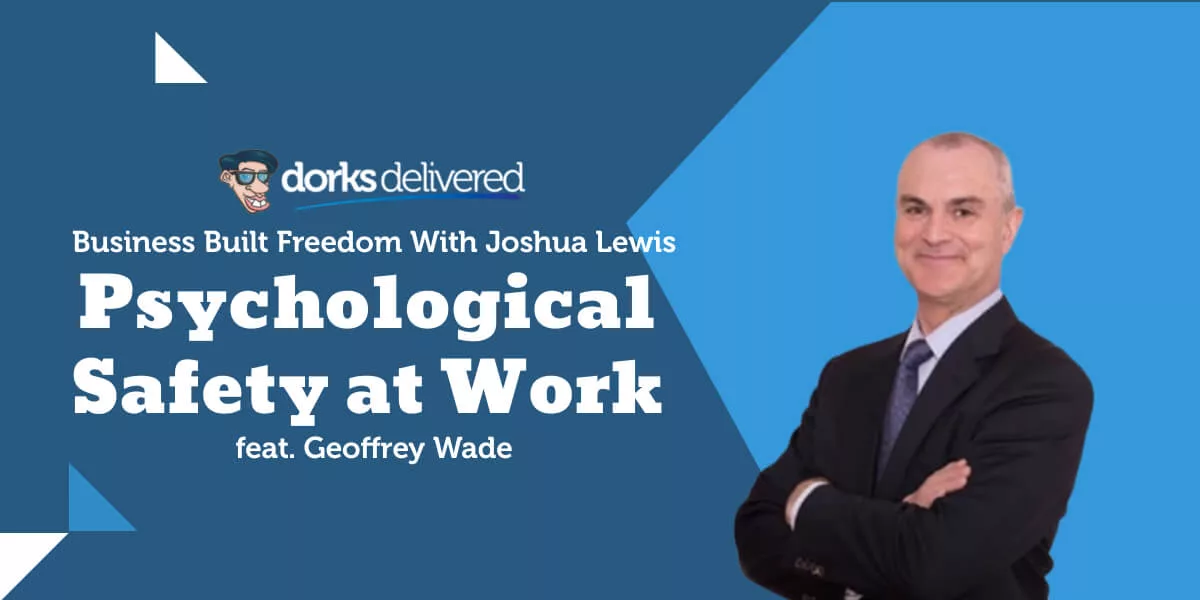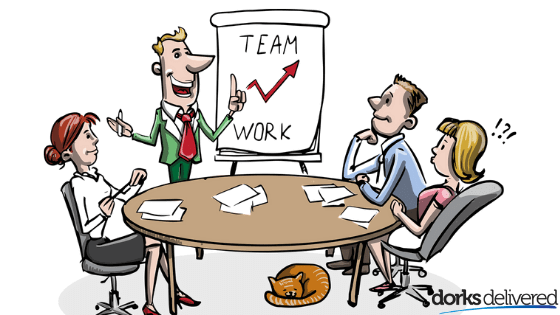A healthy work environment is essential for any business that wants to increase their overall efficiency and happiness. Geoffrey Wade, the founder of Onirik, joined Josh for a deep dive about psychological safety at work.
What Is Psychological Safety in the Workplace?
I prefer to think of it and describe it as team dynamics. Academic nomenclature has its place, but it’s a lot easier to think about it in plain day-to-day terms. Team dynamics cover how we work together with one another, how we communicate with one another, and how we behave with one another. As a leader, we create a culture or an environment where people feel safe to speak up. They are comfortable asking questions. They feel safe to critique the status quo and make mistakes.
In the context of the team in the organisation, they classify mistakes as “learning opportunities” rather than “they made a mistake.” We made a mistake. Let’s clean it up and what did you learn from that? What would you do differently next time?
Safety is not really about creating an environment where we live in cotton wool. By “safe to speak up” I mean we can ask questions like, “What the hell’s going on here?” and the team will take that without feeling threatened because they know the questions are about learning and improvement. We can challenge one another, and we can be a little provocative with one another.
Story Time
I can tell a lot about the research, but I’ll tell a story. It happened in Queensland last year.
There was an underground coal mine up in Northern Queensland. There’s a big heavy machinery underground churning out coal. When you mine coal, there’s a flammable explosive gas, so the mines were carefully designed with ventilation to remove that gas, to make it safe for workers to be there and operate machines, and to avoid undesired explosions. They’ve got a new longwall up and running, and they were getting about 60% more gas from the coal than they anticipated in their design. That was a real problem because they couldn’t evacuate the gas as quickly as they needed. Everyone knew about it—the workers, supervisors, and managers—and they kept running that machine, generating more gas than they could clear.
No one spoke up. You can predict where it went. Thank God no one was killed, but people were injured. The CEO of that company said he was stunned that no one felt safe enough to speak up. People could have died, but they were continuing to work in that really dangerous environment because they didn’t have the psychological safety to speak up.
The Precursor of Other Measures
Psychological safety is the precursor of so many other measures that are important in a business. It is the lead indicator for employee engagement and mental well-being.
It’s a really critical human wellness measure for your workplace, and it correlates with other work satisfaction measures. These then correlate with productivity, performance, customer experience, and growth. And these correlations are not random.
Like many people, I believe employee engagement is an important measure. But as a statistician, I also understand that we can show a correlation in an individual organisation between employee engagement and other performance measures.
You can get Gallup’s data, which was pulled from 200 companies, and then massaged it so it all fits together. Across 200 companies, they could show a correlation between employee engagement and commercial outcomes. In an individual company, you can’t.
With psychological safety, we can show statistical correlations between psychological safety and the KPIs that matter. You get correlation coefficients and impact percentages, and that’s profound. It’s an important measure, particularly when you can show an organisation how they can get a healthier, happier workforce and great commercial outcomes for all other stakeholders, customers, shareholders and the wider community.
Do you want to have more time for more important things? Ask us about automation for your business!
Is It OK To Say Anything?
Is it okay to speak up with almost anything? Can you ask questions that are not politically correct? Yes, you can in a psychologically safe environment.
What sort of questions should be safe to ask? Pretty much any question. Is there a stupid question? No. People ask a question because they truly do not know. They are asking the question in order to learn. They didn’t know and realised that the gap in their knowledge needed to be plugged in because there are real consequences, so they ask the question.
Do the questions have to be politically correct? No. One of the dilemmas that we have in our nation is some well-intended politicians passed laws that say I’m responsible for how you feel about what I say. That law is wrong and fundamentally flawed.
You are responsible for how you feel about what I say, just as I’m responsible for any emotion that I evoke in response to what you say. But I’m also responsible for what I choose to say in response to what you say. I’m responsible for my emotions.
Remove repetitive tasks! Let’s see if automation is for you!
Why Should You Measure Psychological Safety?
We’ve done some workplace-wide studies in Australia, and they’re suggesting that as much as 40% of the workforce is working in that context where psychological safety is low. When we work with organisations and measure it, we find that the number is about 20% to 30% of the organisation.
Psychological Safety Affects Your Team’s Performance
The other thing that we find is there’s a huge correlation between those quadrants and the performance; the teams that have got a high psychological safety are always the ones that are performing the best and they have greater resilience and agility too. They adapt to change more quickly and effectively.
I had a conversation with a leader, who is the head of HR, and he thinks that psychological safety is fine in their organisation, which had 3,000 people in it. I asked him how he knew, and he said it’s subjective and he just feels it.
The observation I made was when psychological safety is low, people don’t speak up, they don’t ask questions, they don’t rock the boat and challenge the status quo, and if they make a mistake, it’s swept under the carpet—there’s silence and invisibility. Will subjective assessment know what’s going on? No. You have to measure it.
When you measure psychological safety, you can see what the return on investment is going to be if you decide to fix it. But you have to measure it and you can do so at a low cost too. There are some tools that show you what it’s costing you or what you can realise in terms of value to fix it.
Some of the measurement tools for human wellness dimensions are hideously expensive. I’m against that because I want organisations to be able to measure the stuff at a low cost and then have a budget to fix the problems. Measuring it should be fast, accurate, and cheap.
Psychological Safety Embraces Diversity and Inclusion
The other thing about psychological safety that’s interesting is it embraces, encourages, and supports diversity. You can ask a provocative question or a different question, and the rest of the team accepts it and doesn’t get offended by it.
You come in and you’ve got an entirely different culture and you speak with a different accent and the team will embrace you because they know that you will have a different perspective because you come from that culture. You will ask different questions, too. Sometimes there’s genius in that, and they want it.
Fear and Anxiety Grow Without Psychological Safety
If you don’t have psychological safety, what you have in its place is fear and anxiety.You’ve experienced fear at some point in your life, whether it’s physical, emotional, or psychological fear. If you recall those experiences, what happens? There’s a kicker of adrenaline and your brain freezes. You go into a fight or flight mode.
Your workforce needs to solve complex problems, manage effective communication, and innovate and deal with change. If you’ve got anxiety and fear and you’ve got a workforce whose higher brain function is compromised, their ability to innovate, solve problems, and deal with change goes out the window.
That’s costly for them because health-wise, they’re running on cortisol and adrenaline and they’re not feeling good. They’re better with endorphins, dopamine, and serotonin—the nice feeling stuff that makes your brain entirely resourceful so you can perform better.
Think of me as a newbie in retail and it’s Friday. I’ve been with the company for a month, and I’ve just had a rocking day. I’ve made 20 sales today, which is the best of the best. I’m performing, a star retailer, after only being with the company for a month. I’m walking out the back of the store, and I tell my boss that I made 20 sales today, but he says, “Yeah, Jeff but your floor is undone, and I really needed you to make 30. Why didn’t you make 30?” What’s going to happen to me?
It’s unlikely I’m going to talk to my boss again next week. He just silenced me for a long time. There are simple things leaders have got to understand in terms of what they say and do in those simple, day-to-day contexts, which have consequences.
There’s a lot of research about trust that says if you screw up but then acknowledge it, own it and fix it, you wind up with deeper trust between you and the other person than if you’ve had a flawless relationship.
Boost your team’s productivity! Ask us how.
How Do the Dynamics of Communication Change With Business Growth?
The answer is not complex. We look at a big organisation and we go, “Wow! How do they do it?” However, the experience of your team and your immediate supervisor trumps the organisation. Certainly, it has to come from the top, but when you think about it, we just do it team by team.
Your average span of control is 9 or 10, so if you have 100,000 employees, divide it by 10. That’s 10,000 teams, so it’s not so much that I have to work with 100,000 people. It’s 10,000 leaders.
If I measure what’s going on, and I find 2,000 have actually got it nailed, another 2,000 that with or two changes would be world-class, another group, say, 3,000 that got quite a bit of work to do, I’m down to the 3,000 leaders who really need attention.
To build psychological safety is not complex. It is about setting some frames. Leaders will say how the team is going to operate and that they don’t know everything and when someone is making a mistake, they need them to speak up, ask questions, contribute ideas.
When we contribute as a team, we will listen to what you have to say, we’ll respect it and no one’s going to put anyone down and ask “where did you get that dumb idea?” People are going to ask you with courtesy and respect, and they will ask enough questions until you realise for yourself that there are holes in the idea and then we pack it and move to the next idea.
We also set the frames in our team that it’s a learning environment. Often, in the organisational context, we think it’s an implementation problem or an execution problem but it’s a learning problem. How do you execute your interactions with feedback and trial-and-error? How do you make a change? You need that learning culture, that learning environment, and the understanding that it’s a learning problem to help you have an agile, responsive, growing organisation.
Whether it’s a team of 5,000 or 50,000, it doesn’t matter. It’s within a team of 5 to 10 people where it happens each time.
You need to measure psychological safety because it’s a tricky beast. It also has commercial consequences and consequences in terms of benefits for the well-being of your workforce. Western nations are passing more and more laws around psychological safety. That’s becoming a compliance issue. You need to be able to show that you have it under control: you’re measuring it, reporting it and managing it. Otherwise, you can be liable for consequences you don’t want.
Do you need extra hands on deck? Enquire about support for one-time or long-term projects.
































